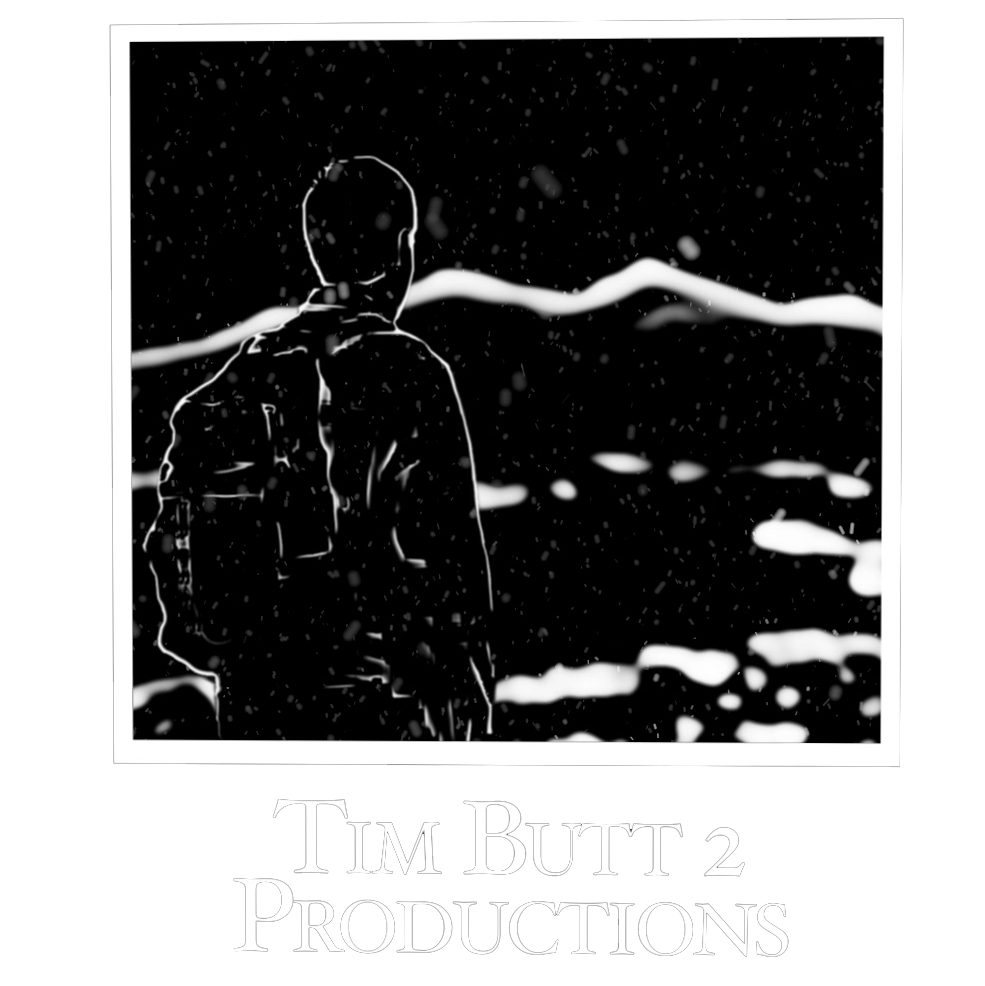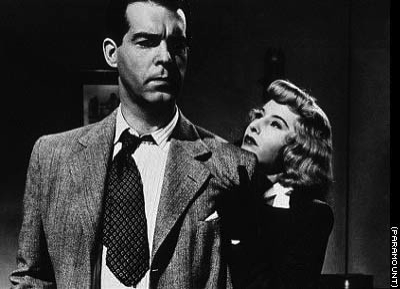Good Strong Men Should Always Avoid Duplicitous Femme Fatales in Film Noir
A deliciously stunning blonde is something to beware. Unlike the dumb blond jokes told so often at the work place, in the realm of film noir a blonde is not to be taken so lightly. That cunning brain will play dem looks to her advantage, coyly showing weakness and big watery eyes. It's the cynical, in over his head protagonist who'll get caught up in whatever scheme she's cooked up, and generally take the fall for her. Disillusioned because of a tarnished past, or perhaps obsessive sexual desire the hero clamors his way through a tight dark place to barely come out surviving, and ultimately losing.
In the 1940s a new style entered the cinemas that was stark, low-key, and ambiguous in its morality. A style that would later be coined as film noir (literally dark film) by the French after World War II when they saw these films that had emerged from America during the war years. Seedy characters in a bleak underworld, fighting to survive, and politicians and other officials caught up in corruption populated the world of these films. So often the protagonist wouldn't come out clean, or started out just as dirty as the rest of those in the gutter. The use of low-key lighting, deep focus photography, disorienting visual schemes, and jarring editing put emphasis on the setting that the protagonist was in, marking his decent.
The sex roles of the classic, yet everlasting, film noir jarred viewer's perspectives on genders that populate its dense asphalt jungles.
The setting was a cause for disdain, as it often brought back a memory. According to Tim Dirks of filmsite.org wrote in his article on film noir, "The protagonists in film noir were normally driven by their past or by human weakness to repeat former mistakes." In Chinatown (1974), Jake Gittes (Jack Nicholson) was one time a cop in Chinatown where he tried to do as little as possible because the potential chance to do more harm than good with all the different dialects was great. Jake was doomed to repeat his mistakes of his past, Chinatown always more a "state of mind" than an actual geographic place, and in the end succeeds in failing. The famous last line, "Forget it, Jake. It's Chinatown," exemplifies the level of corruption Jake has gone up against and lost to, ending up in Chinatown, (first metaphoric and then real.) Jake is essentially a good strong man who has been weakened because of his past and his failure to realize his client is keeping vital information from him, which causes him to do her harm inadvertently. Ken Hillis wrote in Velvet Light Trap that, "I proceed from an understanding of film noir as an historical movement and argue that noir protagonists in films such as Double Indemnity (Wilder, 1944), Mildred Pierce (Curtiz, 1945), The Dark Corner (Hathaway, 1946), D. O.A. (Maté, 1950), The Big Heat (Lang, 1953), and The Big Combo (Lewis, 1955) reflect an existential, often despairing, awareness of the impossibility of their own enlightenment and, by extension, of ever realizing the American Dream" (par. 1). One can only venture to guess that noir can't have such a narrow viewpoint towards women.
In noir there are two archetypes under which woman can fall under — "dutiful, reliable, trustworthy and loving women; or femme fatales - mysterious, duplicitous, double-crossing, gorgeous, unloving, predatory, tough-sweet, unreliable, irresponsible, manipulative and desperate women" as Dirks points out in his article. To believe that any bright and attractive girl could be calculating and cold towards men must ring to some man's poor experiences with a woman. For the femme fatale to show up in so many noirs in this fashion displays some sort of mass conspiracy among men to find that any girl who is smart to be a bad thing. If the "dutiful, reliable, trustworthy, and loving women" are what men are searching for, then perhaps they best search for it in a dog. Noir did come about in the 40s and lasted through the 50s (though there have been many post, or neo-noirs, since) and the portrayal of woman could be going with the stereotypes of that era. Yet, some how at the same time it seems to fit rather well into many women one has encountered. Could they really be capable of falling into one of the two archetypes?
Elisabeth Bronfen, Femme Fatale-Negotiations of Tragic Desire, makes the point:
Indeed, if one follows Felski's suggestion that tragedy be thought of less as a genre than as an attitude which addresses the limits of modern dreams of perfectibility, then the femme fatale can be understood as a particularly resilient contemporary example of tragic sensibility. For in the world of a film noir like Double Indemnity, where actions occur "accidentally on purpose," she functions both as the screen for fantasies of omnipotence and as the agent who, by ultimately facing the consequence of her noir actions, comes to reveal the fragility not only of any sense of omnipotence that transgression of the law affords, but, indeed, of what it means to be human.
Thus making a woman who acts like that of the femme fatale human. Bronfen continues to explain how Phyllis Dietrichson (Barbara Stanwyck), the femme fatale of Double Indemnity (1944), toys with fate insofar as to tell her lover, Walter Neff (Fred MacMurray), who she's convinced to assist in discarding her husband and tricking his insurance company out of money because of their double indemnity clause, that everything from there on is "straight down the line for both of us." Phyllis wraps her finger around danger completely, leaning over the edge calling for gravity to ensnare her and pull her into the pit. It is like the insurance investigator Barton Keys (played miraculously by Edward G. Robinson) says, "They've committed a murder and it's not like taking a trolley ride together where they can get off at different stops. They're stuck with each other and they've got to ride all the way to the end of the line and it's a one-way trip and the last stop is the cemetery."
Why do the men of noir do it? What drives them to follow these femme fatales? The protagonist of a noir catches a single note of those golden harps and their hooked. Just like the Ole "Swede" Anderson (Burt Lancaster) in The Killers (1946). Bronfen claims, "From the moment the hero catches sight of the femme fatale, both find themselves caught in a sequence of events which can go only one way." From the moment the Swede lays eyes on Kitty Collins (Ava Gardner) he is hypnotized. Those golden harps wrapped around him and wouldn't let him go until he died (in this instance at the beginning of the movie and we follow a journey to learn why would a man just lie there and take it). Through the course of eleven flashbacks we learn this fragmented story of the Swede, right done to the double-crossing dame who sent him to his death. There is no answer to why he does what he does. Love perhaps? The answer is in the soul of the doomed protagonist.
There is some kind of psychology that drives the characters that make up the universe that is noir. The decadent society that surrounds them could have a great deal to do with it, but so much of the society that they come from is based in reality. The men are stereotypes of men in classic society and the women are stereotypes of women through the eyes of classic society men. In Psychology Constructs the Female by Naomi Weisstein, Weisstein writes, "They not only assert that a woman is defined by her ability to attract men, they see no alternative definitions. They think that the definition of a woman in terms of man is the way it should be" (584). Weisstein is combating the writings of other, manly, psychologists who are claiming that the purpose of a female in the mind of a female is to attract a make companion and find a home. If film noirpresents this in any way it is definitely without a doubt the "dutiful, reliable, trustworthy, and loving women" as opposed to the femme fatale. The femme fatale, although, at the same time will use the traits that Weisstein's psychologists claim to belong to woman in order to settle into a life and then manipulate. Weisstein boasts that women want nothing of what a man thinks they want and that psychology cannot define these wants, but instead that woman are equals to men and just as smart. In noir never do we find a female in the role of the protagonist and a male in some sort of male fatale role.
One reason why a male could never take on the male fatale role is because men have such a large amount of control in society and still retain that control. It is still considered a man's world and men still judge other men based upon how manly they present themselves. Robert Brannon writes in his essay, Why Men Become Men, and Other Theories, "We men are not supposed to let others know when we feel scared or depressed or even when we feel happy or in love. At the emotional level we're supposed to even things out." Without any doubt this is describing practically any male one would find in a film noir. The key characteristics that make-up the femme fatale never could fit into the way a man in noir is supposed to be looked at.
There is no escaping the past, no matter how hard one runs. Film noir is iconic and its portrayal of men and women is such a clear-cut vision that it jolts the perspective on the sex-roles in American society for the viewer. "It's straight down the line for both of us."
WORKS CITED
Dirks, Tim. "Greatest Films: Film Noir." Greatest Films, <http://www.filmsite.org/filmnoir.html>. June 2005. (December 4th, 2006).
Chinatown. Dir. Roman Polanski. Perf. Jack Nicholson, Faye Dunaway, and John Huston. Paramount. 1974.
Hillis, Ken. "Film Noir and the American Dream: The Dark Side of Enlightenment". Velvet Light Trap. Spring 2005: 16 pp. November 30, 2006. <http://proquest.umi.com/pqdweb?index=5&did=825042761&SrchMode=1&sid=6&Fmt=4&VInst=PROD&VType=PQD&RQT=309&VName=PQD&TS=1164903407&clientId=18133>.
Bronfen, Elisabeth. "Femme Fatale-Negotiations of Tragic Desire". New Literary History. Winter 2004: 14 pp. December 3, 2006. <http://proquest.umi.com/pqdweb?did=627717311&sid=1&Fmt=3&clientId=18133&RQT=309&VName=PQD>.
Double Indemnity. Dir. Billy Wilder. Perf. Fred MacMurray, Barbara Stanwyck, and Edward G. Robinson. Universal. 1944.
The Killers. Dir. Robert Siodmak. Perf. Burt Lancaster, Ava Gardner, Edmond O'Brien, Albert Dekker, and Sam Levene. Universal. 1946.
Weisstein, Naomi. Psychology Constructs the Female. Eds. Susan McLeod, John Jarvis, Shelly Spear. Nevada: Thompson Wadsworth, 2005.
Brannon, Robert. Why Men Become Men, and Other Theories. Eds. Susan McLeod, John Jarvis, Shelly Spear. Nevada: Thompson Wadsworth, 2005.



